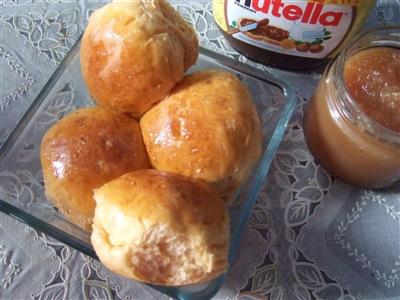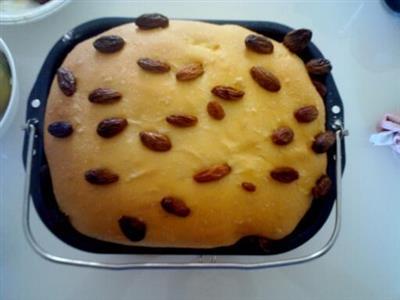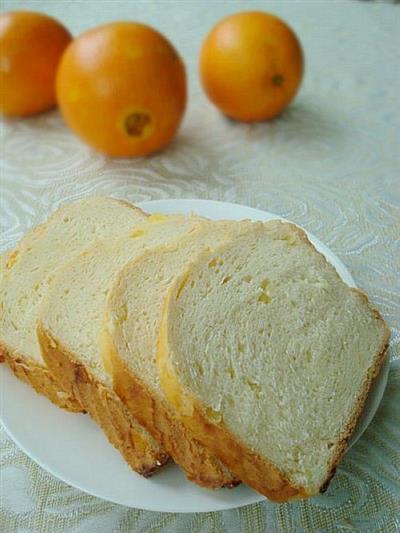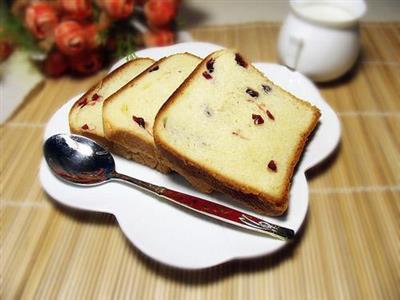Nicholas and I

Among the many varieties of bread suitable for home baking, it is worth mentioning that it is a bit difficult.Its main difficulty lies in the fact that the so-called layer is wrapped in a large amount of fat in the fermented dough, the layers are unwrapped, so that the layer of dough covers the fat, in the high-temperature baking presents the effect of layering the dough, the entrance of the dough is crisp and fragrant.The number of times the dough is folded varies, so you can get a different taste of the dough.Nikolaus is the most basic type of bread.In the words of the author of the original recipe, this is his original bread, which has a crispy taste and a soft texture.Looking at its recipe and practice, it is characterized by the use of a large amount of fermented cream and the use of a three-fold three-fold method.Folded into fermented cream, not only the nutrients are more easily absorbed, but also the taste is very unique; the fat content of fermented cream is high, the moisture content is low, the elasticity is very good, it is suitable for folding blankets.Buy fermented cream, mainly depending on whether the recipe contains fermentation agents, fat content of more than 80% ⁇ In fact, it is also possible to use ordinary unsalted butter with a higher fat content.Three times three folds, is the easiest way to fold the blanket, its characteristics are not only easy to operate, but also the finished product has a very good texture, the layers are clear, the taste is crisp, the internal structure is very soft.
WHAT YOU NEED
Ingredients
500 grams of wheat flour8 grams of quick fermented yeast powder15 grams of skimmed milk powder55 grams of fine sugarA moderate amount of whole egg juice10 grams of saltClean water 300 grams25 grams of unsalted butter375 grams of fermented butter
How TO MADE Nicholas and I
Steps 1 to 4
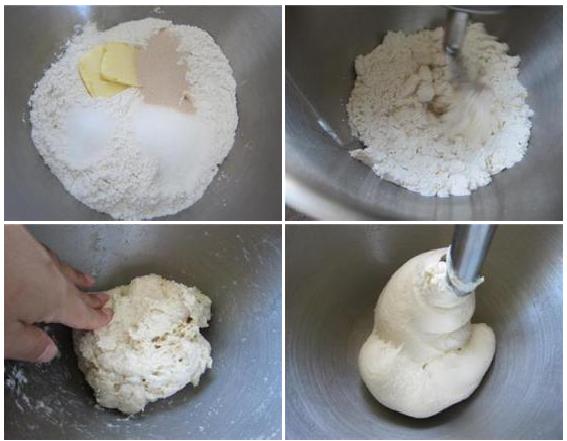
1. The flour, water, salt, yeast, milk powder, sugar and softened unsalted butter are placed in the mixing bowl of the cooking machine;
2. Start the cooking machine, stir slowly and slowly add clean water, do not add it all at once, leaving about 20 g to adjust the softness and hardness of the dough;
3. Stir until the dough is cooked to check the degree of the dough, the dough is slightly softer and easier to handle, add clear water as desired;
4. Continue stirring slowly until the surface of the dough is smooth;
Steps 5 to 8
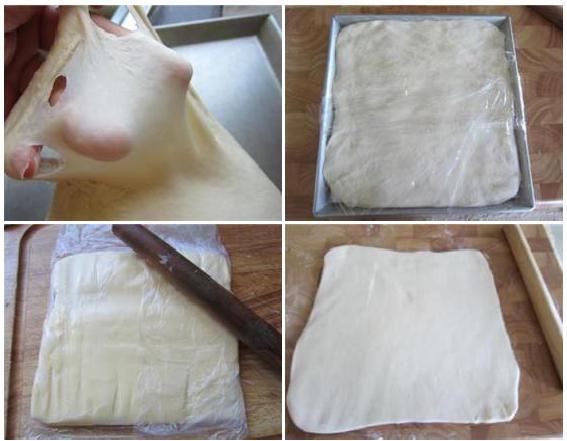
5. Check the firmness of the dough: take a small piece of dough and slowly unfold it so that it can be pulled into a thin film;
6. Remove the dough, spread it on a plate, cover it with a preservative film, refrigerate it in the refrigerator for one hour (yes! it's frozen! to delay the fermentation of the dough, it's easy to fold the dough);
7. When the dough is about to freeze, remove the refrigerated fermented butter from the refrigerator, cut it into thick slices, put it in a preservative bag, and beat it into large thick slices with a doughnut stick;
8. Remove the dough and knead it into slices about twice the size of the fermented butter;
Steps 9 to 12

9. Place the butter in the center of the plate;
10. Wrap the butter slices in bread and squeeze them together;
11. Beat the dough with a stick so that the dough sticks tightly to the butter, and if there are bubbles, make small holes with bamboo sticks;
12. The screen is cut into large slices;
Steps 13 to 16

13. Folded in three;
14. Take it off one by one, open it again, and it grows into a square.
15. Folded into three again;
16. Place in a tray, cover with a preservative film, refrigerate in the refrigerator for 30 minutes to 1 hour;
Steps 17 to 20
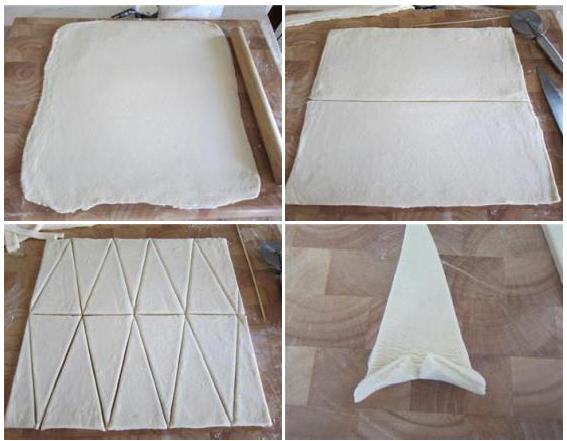
17. After 30 minutes, remove the dough and knead it into a large square slice about 40 cm long and about 4 mm thick;
18. Divide the large panel into two large slices about 18 centimeters wide;
19. Cut with a blade into an equilateral triangle about 9 cm wide at the bottom and 18 cm high;
20. Cut a small opening of about 1 cm in the center of the bottom of the equilateral triangle, slightly apart from the small opening;
Steps 21 to 24
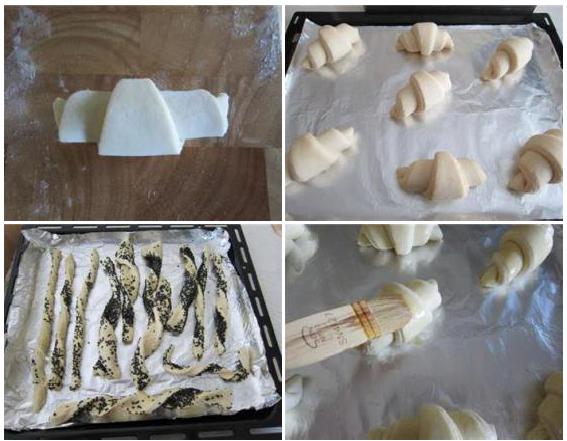
21. The top corner of the equilateral triangle should not be too loose or too tight, so that it can be rolled naturally.
22. After the whole roll is cooked, it is evenly poured into the baking tray (preferably a layer of tin paper to facilitate cleaning the baking tray), leaving a sufficient distance between the rolls, and the final fermentation is carried out at room temperature;
23. The edges should not be wasted, but should be braided or wrapped in sesame seeds for final fermentation.
24. When fermented to twice the size, brush evenly on a thin layer of egg juice, brush only the surface, be careful not to brush to the side layered parts, so as not to affect the crust.
Steps 25 to 28

25. The middle layer is placed in a 220-degree oven and baked for 12 to 15 minutes.
26.
Handy cooking tips
During the baking process, a small amount of oil will leak out, which will disappear after baking.If there is a large amount of oil spilled, it indicates that the operation was wrong and the mixture was mixed.
REACTION RECIPES
- Rose peanut butter cake
- The lemon
- It's a small cake, but it's delicious.
- Cranberry cookies
- Margaret, please.
- Fingers crossed
- Margaret's cookies
- Greek coconut
- Cinnamon cookies
- Failure - sesame flavored butter cookies
- Super simple finger cookies
- Yoghurt and beans
- Tea and honey bean cookies
- The little lion is a two-color cookie.
- Gift box cookies
MOST POPULAR RECIPES
- Bread in the form of raisins
- Banana bread roll
- Milk toast and bread
- Similar to cod bread
- English cranberry sauce
- Orange leather cow horn bag
- Chocolate dragon cat bread
- Cheese molecules
- A small meal pack of oil curry
- Fruit bread
- Bread machine toast
- Sesame sugar bags
- Souped cranberry and pumpkin bread
- Quick handed honey bags
- Red sugar corn bread

 DESSERTS
DESSERTS  BAKING
BAKING  MAIN DISHES
MAIN DISHES  SNACKS
SNACKS  CHINESE FOOD
CHINESE FOOD  HOME
HOME